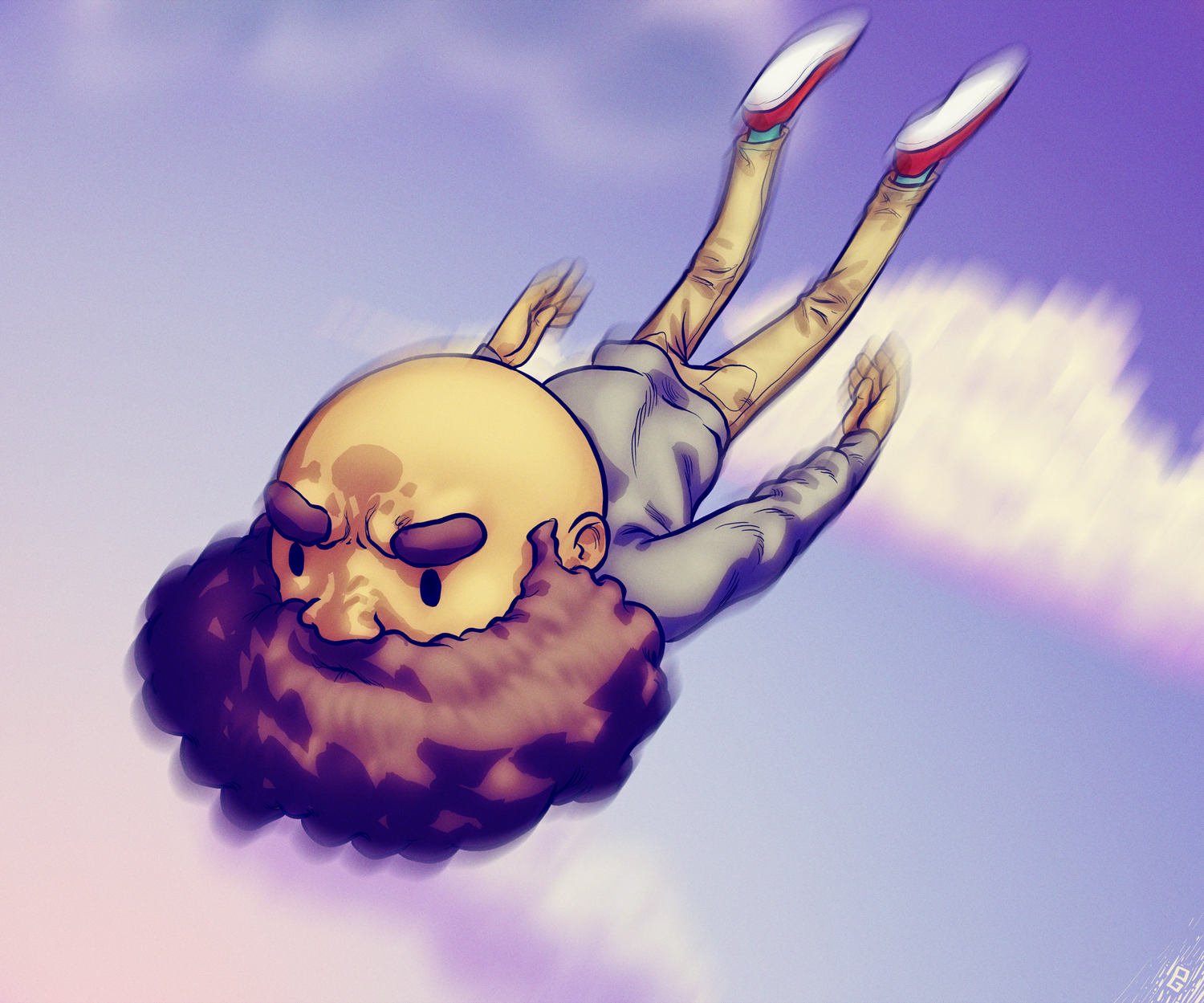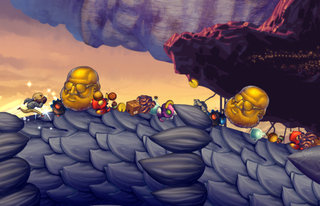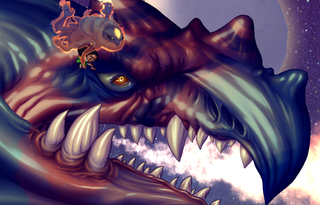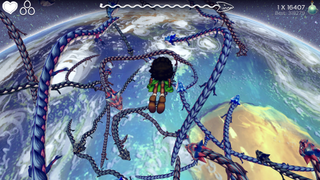EarthNight: a freerunner where you stab dragons

Rich Siegel thinks that freerunners have some growing to do. “I feel like a lot of [runners] become more like slot machines,” he told me. As lead developer of EarthNight at Cleaversoft, Siegel is attempting to invigorate a stagnant genre with a dose of the bizarre. And in a game that sends the player falling unprotected from space through a writhing tangle of massive dragons, only to land on and run up one of the beast’s backs to stab it in the face—I’d say that EarthNight is weirder and more interesting than any freerunner in recent memory.
Siegel sent over a build of the game for me to try out. And while it’s far too early to proclaim a grand revival, even in it’s early state, EarthNight feels like a game with a fiery heart and formidable talent in every facet of development.
Nowadays, the typical freerunner asks you to jump and juke, building a score based on paywall multipliers until your inevitable, expensive downfall. They’re usually based on an existing brand or some generic, paper-thin narrative to justify their mechanics and indifferent art direction. While their existence certainly isn’t invalid, they aren’t burgeoning pillars of game design.

But EarthNight is seeking to set itself apart from the pack through a heavy investment in aesthetic scaffolding for its minimalist mechanics. I started in a spaceship, a detailed and expressive diorama that framed my option to play as one of two characters, 14-year-old Sydney, or Stanley, a freelance photographer with a robust beard. Each plays differently: Sydney is the more complex and technical of the two. She can double-jump, the arc of which depends on the minute timing of button presses. Stanley is more straightforward, meant for players who may not be able to as easily grasp Sydney’s precise timing. Each character can jump and chain leaps off the heads of enemies. Doing so ensured that I could maintain momentum, allowing me to reach higher platforms and rarer items that improved my maneuverability and damage output. But don’t expect to necessarily memorize or master entire dragons. Each is procedurally crafted from about 350 carefully designed “chunks” meant to integrate with one another to form a level.
Over the course of repeated runs, Siegel expects the procedurally generated dragons to pepper the experience with items and layouts that lean into narrative and gameplay discovery. In my time, no one dragon felt identical to another. There were moments of familiarity, a la Super Hexagon, but I was forced to stay attentive in order to succeed.
At a glance, the chaos often resembles a surreal, animated landscape painting.
Throughout each level, an expressive cast of monsters danced in swarms above and hordes below, all bent on destroying my momentum and draining my health. Sometimes I let it happen, distracted (in a good way) by the colorful chaos.
At a glance, this chaos often resembles a surreal, animated landscape painting—which is entirely the point. Every asset is handpainted, and there are plenty. Beyond that, animated assets, like the two player characters, are painted for every frame of animation. According to Rich, that’s approximately 350 to 400 times. Responsible for the incredible output is Mattahan (slightly NSFW), aka Paul Davey.
The biggest gaming news, reviews and hardware deals
Keep up to date with the most important stories and the best deals, as picked by the PC Gamer team.

Shades of Colossus
Each stage terminates at the dragon’s head, triggering a QTE sequence. Before the time runs out, you have to slay the dragon by hitting cryptically timed button presses. I’m not entirely sure, but it felt like timing my presses with the music did more damage. Feeling like I had to intuit a rhythm from the soundtrack was a highlight of my experience with the game. It heightened the drama of a small interaction and made me feel closer to the game. It’s a gratifying finale to an often difficult sprint, and triggered memories of Shadow of the Colossus, a game Siegel cited as a big influence.
Afterwards, the player seamlessly transitions into a skydive towards the planet, a sea of dragons beneath them. This is a level select of sorts—whatever dragon the player lands on begins the next level, but it’s also offering what Siegel feels most freerunner games are missing. “At the end of the dragon you get to jump off and have this moment of beauty. There’s nothing attacking you, there’s no urgency, you can just take a moment.” As someone who loves the urgency in freerunners, but not the endurance required, this was a welcome design choice. During those freefalls, when everything slows to a decadent crawl, the soundtrack moves to the foreground and chimes a sweet, sorrowful tune.
Behind the chiptune soundtrack is renowned Philadelphia musician Chipocrite, aka Paul Weinstein. However, Siegel says Chipocrite has grown beyond the typical chiptune sound, “[Chipocrite’s] style has evolved from just a Gameboy to a Gameboy with a band.” From what I’ve heard in the game and in the trailer, the soundtrack is certainly more dynamic and full than a lone Gameboy, evocative of the game’s derelict world and desperate attempt to reclaim it. In the build I played, there wasn’t much gameplay integration with the soundtrack, but Siegel is set on invoking synesthesia if he can. “Nearly everything in a given level is done on a time trigger.” I’ve yet to only see glimpses of the musical integration, so I can only hope that the final build holistically marries the gameplay and music in a meaningful way.

Either way, the free falls are the most necessary rhythmic component, because EarthNight gets very difficult, very quickly. Siegel mentioned that persistent upgrade mechanics will be present, but made it clear that they won’t be monetized. That’s great news, though I can’t help but wonder how the final balance will play out. The upgrade curve isn’t clear yet, and how it tips the player over each hump will likely determine longevity for some. At the moment, the jumping mechanics feel fine, but I’m not sure how much of my inherent fumbling was due to the game’s early state or my infantile spot on the learning curve.
Whatever questions the early build might inspire, EarthNight makes some bold proclamations. It seeks to redeem the freerunner genre and stand out on it’s own via an investment in art, narrative, music, and heartily considered design. And how long that might take depends on Siegel’s satisfaction. “I’m not some company trying to cash in on a trend. I’m trying to make a work of art that I think is a real good video game.”
Expect EarthNight on PC (Steam, GOG) on or very close to the release of the PS4 and Vita versions.
James is stuck in an endless loop, playing the Dark Souls games on repeat until Elden Ring and Silksong set him free. He's a truffle pig for indie horror and weird FPS games too, seeking out games that actively hurt to play. Otherwise he's wandering Austin, identifying mushrooms and doodling grackles.
Most Popular




